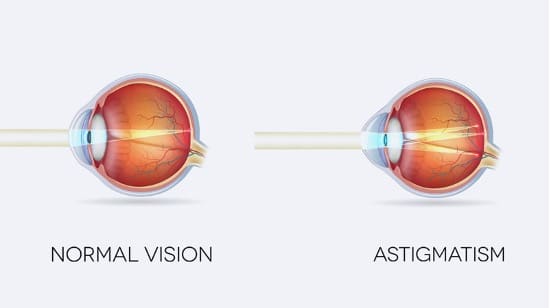Astigmatism
Astigmatism is a common and generally treatable imperfection in the curvature of the eye that causes blurred distance and near vision.
Astigmatism occurs when either the front surface of the eye (cornea) or the lens inside the eye has mismatched curves. Instead of having one curve like a round ball, the surface is egg-shaped.
If you have any concerns about your vision, please call 07 3345 3383 to book a comprehensive assessment.

- Horizontal astigmatism is when the eye is wider than it is tall
- Vertical astigmatism is when the eye is taller than it is wide
- Regular astigmatism occurs when the eye isn’t completely curved. So instead of being round like a basketball, it might take the shape of a football.
- Irregular astigmatism, which is less common, also occurs when the eye isn’t completely round. But unlike a regular astigmatism, where the eye is evenly misshaped, an irregular astigmatism has an uneven curvature.
With any type of astigmatism, near and far vision is blurry because of the eye’s irregular shape.
What Causes Astigmatism?
- Genetics
Often present at birth, but may develop later in life - Eye injury
Scarring or thinning of your cornea. - High prescription
Excessive nearsighted or farsightedness - Regular eye rubbing
Due to eye allergies - Eye disease
Keratoconus affects the cornea, causing the clear tissue to thin and bulge out - Eye surgery
Such as cataract surgery
Signs of Astigmatism
- Blurry vision or areas of distorted vision
- Eyestrain
- Headaches
- Difficulty with night vision
- Glare / light sensitivity
- Squinting to try to see clearly, or
- Eye discomfort
However please note that these symptoms do not always mean you have astigmatism.

What Do The Numbers Mean In My Prescription?
Astigmatism is measured in diopters. A perfect eye with no astigmatism has 0 diopters. People with a measurement of >1.5 typically need contacts or eyeglasses to have clear vision.
Of the three numbers on your contacts or glasses prescription, the last two refer to astigmatism:
- Spherical indicates whether you are nearsighted or farsighted. A plus sign indicates you are farsighted, a minus sign indicates you are nearsighted. The higher the number, the stronger your prescription.
- Cylinder measures what degree of astigmatism you have, or how flat or irregular the shape of your cornea is. The more your eye looks like an American football (instead of a basketball), the more astigmatism you have.
- Axis is measured in degrees, and refers to where on the cornea the astigmatism is located. Axis numbers go from 0 to 180. If you think of the eye as a map hanging on a wall, the 90 degree axis or line, runs up and down (or north to south) on the eye. The 180 degree line runs across the eye, east to west.
Treatments
- Reduce eye rubbing
Use lubricating eye drops or see a therapeutically qualified optometrist to prescribe allergy eye drops. - Eyeglasses or contact lenses
They work by refocusing light on the retina in the back of your eye so that you can see more clearly.- There are two main types of contact lenses for astigmatism:
- Toric soft lenses
- RGP (rigid gas permeable)
For more severe astigmatism, RGP lenses may work best.
- There are two main types of contact lenses for astigmatism:
- Orthokeratology (Ortho-k)
These are hard contact lenses that mold the shape of your cornea while you sleep, allowing clear vision during the day without the need for additional corrective lenses. The benefits of Ortho-K are only present when using it, as your vision will return to its previous state after stopping Ortho-K.

Summary
The exact cause of astigmatism isn’t known, and treatment might be necessary depending on the extent of this eye condition.
Wearing contact lenses or glasses can improve vision. Treatment not only helps vision, it can reduce the risk of complications like a lazy eye, eye strain, and headaches.